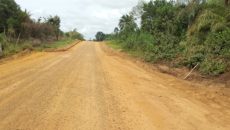MONROVIA, Montserrado – On February 20, 2018, a massive fire erupted on Randall Street in the Power Tech building, destroying businesses and homes within the facility.
While all the details of the fire are not known, workers in the building said the fire started at approximately 8:00 a.m. and came from an electrical appliances warehouse located between Randall and Mechlin streets.
At the time of the fire, the managing director of Power Tech, Eli Nassim Ghandour, described the incident as a disaster for his business. The fire destroyed many goods and resulted in some individuals attempting to loot the affected stores.
A maid working in one of the residential building, Janet Tulay, noted that she first noticed there was a fire when she saw a wire drop on the zinc of the warehouse.
She said she and her employers evacuated the building, leaving all their belongings there, except for their passports.
On the scene that day was Vice President Jewel Howard-Taylor, who comforted the victims and requested to know the root of the fire.
While this incident attracted a significant amount of attention, with footage even broadcasted live online via KMTV, the fire was only one of at least 12 that occurred in the Monrovia area in the first two months of the year, according to the Liberia National Fire Service. Among them were two major incidents that led to the loss of lives and valuable properties.
They include a January 19 incident in Sinkor in a residential home that left 37 persons homeless and the Pagos Island outbreak which killed five persons.
The Fire Service’s communications director, Yassah Ganyah, said many of the recent fire outbreaks that occurred in the city were either caused by electrical shocks or by lit candles which inadvertently caused larger fires.
She said the Randall street fire incident was particularly difficult to quench because of the closeness of buildings that prevented the fire truck from moving freely.
“Every house should [be] 37 feet away from each other,†she explained. A warehouse which was also affected by the Randall Street fire was apparently built in the alley that separates Mechlin and Randall Streets. It took more time than required to calm the fire because of insufficient space for the free passage of the fire truck.
In a country where many structures spontaneously sprout up across the city, Ganyah said unauthorized and illegally constructed buildings were major factors contributing to the fire outbreaks being more difficult to tame. She said only a few individuals followed proper safety guidelines before undertaking construction projects.
While some buildings housing businesses have smoke detectors and fire extinguishers, for example, she observed that most do not observe required safety protocols. It was not clear if the warehouse involved in the Randall street fire contained fire safety devices such as smoke detectors, as the management declined to speak on the issue.
But Ganyah said Liberia has many regulations to guide the construction of buildings in the city, including ones that provide guidance for fire safety. However, she admitted that the regulations are mostly ignored, noting that low budgetary support to the National Fire Service not only prevented the agency from being equipped to enforce regulations but that it also impedes the effectiveness of firefighters when there are fires.
The lack of enforcement of existing laws and regulations in Liberia is an old problem that has afflicted the country since the end of the war and the Liberia National Fire Service is not the only agency at fault. At the Ministry of Public Works, the director of zoning said it was difficult to implement zoning laws because most buildings in the city were in existence before the creation of the ministry. However, the agency was initially created in 1928 as the Department of Public Works and later changed to the Ministry of Public Works. The vast majority of buildings in Liberia were constructed after 1928. Even so, buildings constructed in recent years are largely not compliant with existing codes.
Taplah said there are procedures and rules in place to determine where specific types of buildings can be located. For example, she said warehouses such as the one responsible for the Randall Street fire, are required to be located on Bushrod Island, near the port, instead of being between residential buildings.
“Before you build, you must have gone through the process required, and if you build without the permit of the ministry and we find out, you get punished,†she said. “Sometimes we mark houses to be removed because they are not built in the right place and right way.â€
However, Taplah appears to be overstating the enforcement capabilities of the ministry. Across Monrovia, there are marks made by the Ministry of Public Works on structures that are presumably in violation of various laws. Those structures are almost never demolished.
Liberia has in place a law that governs what types of structures that can be built in various areas, in addition to the regulation of land use around the city. That law, the Zoning Act of 1958, provides eight different classes of districts which can determine how land can be used in the city (four residential classes, three business classes, and one industrial class).
The Zoning Act is supposed to accompany a zoning map, which should specify which parcels of land in the city should be restricted to each class.
For a government agency that has made numerous past public statements encouraging the public to respect zoning laws, it is notable that the Ministry of Public Works’ website does not carry a copy of the law. Moreover, in order for the law to make sense, it must be accompanied by a zoning map, which several officials acknowledge no longer exist. Officials within the ministry use their personal knowledge to determine the location of the different zoning classes.
Featured photo by Mafanta Kromah



